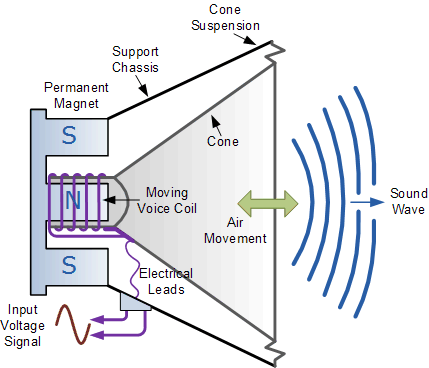 So, where does this voltage come from? Certainly not the turntable, CD player, or DAC we might be using for our media. These devices and their associated electronics produce no more than 2 volts. How about a preamplifier? Not much better for voltage. While some preamps can manage upwards of 10 volts at their outputs, more typical is only a few.
We get those higher volts from our power amplifier's first stage. A typical input voltage gain stage of a preamplifier is nothing more than a glorified preamplifier without a volume control. Place 1 volt into this input stage and you get (typically) 30 out. We'll discuss more about this section tomorrow.
Once we have thirty times the voltage we started with from our source or preamp, we have a problem. That higher voltage stays high only into air (high impedance). Try placing that high voltage into a low impedance, like that of a speaker, and it collapses back to near nothingness. This is where the second stage of our power amplifier, the output current gain stage, takes over. Place a voltage into one end of this circuit and the same thing comes out its output, only stronger and unaffected by low impedance.
More tomorrow.
So, where does this voltage come from? Certainly not the turntable, CD player, or DAC we might be using for our media. These devices and their associated electronics produce no more than 2 volts. How about a preamplifier? Not much better for voltage. While some preamps can manage upwards of 10 volts at their outputs, more typical is only a few.
We get those higher volts from our power amplifier's first stage. A typical input voltage gain stage of a preamplifier is nothing more than a glorified preamplifier without a volume control. Place 1 volt into this input stage and you get (typically) 30 out. We'll discuss more about this section tomorrow.
Once we have thirty times the voltage we started with from our source or preamp, we have a problem. That higher voltage stays high only into air (high impedance). Try placing that high voltage into a low impedance, like that of a speaker, and it collapses back to near nothingness. This is where the second stage of our power amplifier, the output current gain stage, takes over. Place a voltage into one end of this circuit and the same thing comes out its output, only stronger and unaffected by low impedance.
More tomorrow.
Thirty times bigger

 So, where does this voltage come from? Certainly not the turntable, CD player, or DAC we might be using for our media. These devices and their associated electronics produce no more than 2 volts. How about a preamplifier? Not much better for voltage. While some preamps can manage upwards of 10 volts at their outputs, more typical is only a few.
We get those higher volts from our power amplifier's first stage. A typical input voltage gain stage of a preamplifier is nothing more than a glorified preamplifier without a volume control. Place 1 volt into this input stage and you get (typically) 30 out. We'll discuss more about this section tomorrow.
Once we have thirty times the voltage we started with from our source or preamp, we have a problem. That higher voltage stays high only into air (high impedance). Try placing that high voltage into a low impedance, like that of a speaker, and it collapses back to near nothingness. This is where the second stage of our power amplifier, the output current gain stage, takes over. Place a voltage into one end of this circuit and the same thing comes out its output, only stronger and unaffected by low impedance.
More tomorrow.
So, where does this voltage come from? Certainly not the turntable, CD player, or DAC we might be using for our media. These devices and their associated electronics produce no more than 2 volts. How about a preamplifier? Not much better for voltage. While some preamps can manage upwards of 10 volts at their outputs, more typical is only a few.
We get those higher volts from our power amplifier's first stage. A typical input voltage gain stage of a preamplifier is nothing more than a glorified preamplifier without a volume control. Place 1 volt into this input stage and you get (typically) 30 out. We'll discuss more about this section tomorrow.
Once we have thirty times the voltage we started with from our source or preamp, we have a problem. That higher voltage stays high only into air (high impedance). Try placing that high voltage into a low impedance, like that of a speaker, and it collapses back to near nothingness. This is where the second stage of our power amplifier, the output current gain stage, takes over. Place a voltage into one end of this circuit and the same thing comes out its output, only stronger and unaffected by low impedance.
More tomorrow.
0 comments